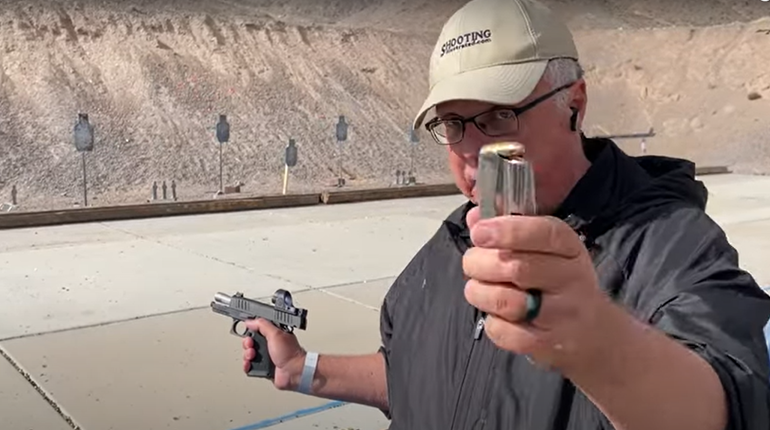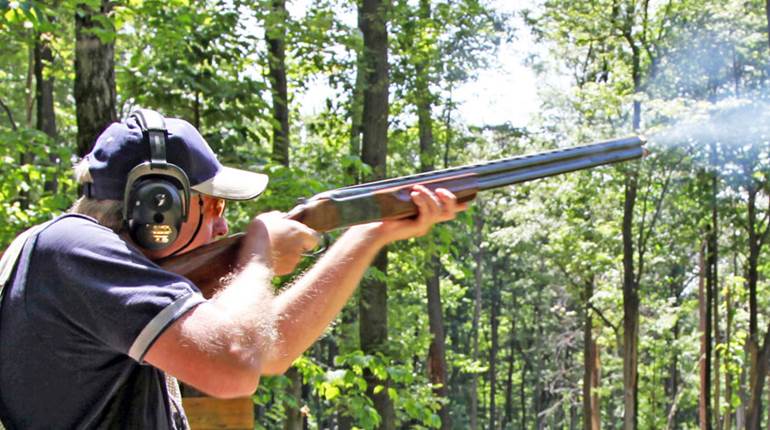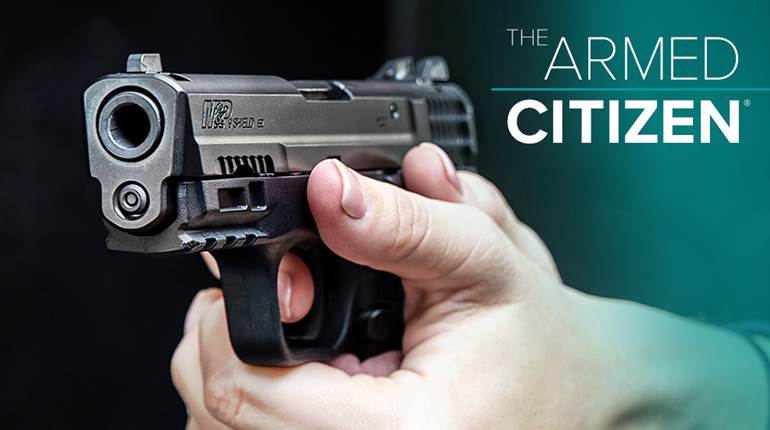
From The American Rifleman, September 1995.
The U.S. Army wasn’t particularly impressed with the concept of a submachine gun, and little ordnance research and development was done following World War I. However, a distinguished Ordnance Dept. officer who retired a couple of years before America’s entry into that war felt that the submachine gun had the potential to be an extremely valuable arm.
John Taliaferro Thompson entered the U.S. Army in 1882 and made a name for himself during the Spanish-American War directing the supply of munitions during a time of near chaos. Thompson was later a key player in the development of two legendary American military arms—the M1903 Springfield rifle and the M1911 .45 pistol. He was recalled to active duty in late 1917 and was named Directory of Arsenals and charged with supervising small arms production.
After the war, Thompson became very interested in, if not obsessed with, the concept of a “trench broom,” as he called it, for close quarter fighting. He recognized that the .45 ACP cartridge would be ideal for use in such an arm. The heavy slug could provide a great deal of short range stopping power, particularly when fired from a full-automatic arm.
While working on a semi-automatic rifle design, Thompson became enamored of a locking mechanism developed by a U.S. Navy officer, John B. Blish. The Blish principle used a sliding wedge as a locking device. Thompson chose to adapt the Blish locking mechanism to his “trench broom.”
Thompson assembled a talented team of designers and, by 1919, the new firm of Auto-Ordnance was involved in developing the first American submachine gun to see production. Several magazine designs were evaluated, but it was decided that box magazines and a novel drum magazine would offer the best service.
The most natural market for Thompson’s new gun was, of course, the U.S. Military. When he brought up the general concept in 1917 to a number of Ordance Dept. officers they expressed interest. The Navy also thought that such an arm might be of value to Marine and Navy landing party duties.
By early 1920, Auto-Ordnance was ready to have its prototype tested by the government. On April 27, 1920, the Springfield Armory conducted preliminary functioning tests and the results were very impressive, as 2,000 rounds were fired with only one stoppage.
The Marine Corps tested the gun a few months later at Quantico, Virginia, with similarly favorable results. Even though no official trials had been scheduled, Auto-Ordnance began plans to have the new gun mass produced. Contracts were eventually negotiated with Colt for the manufacture of 15,000 “basic firing mechanisms” and with several other firms including Lyman and Remington, for items like sights and walnut stocks. They were to be assembled by Auto-Ordnance at its own facility.
The new arm was designated “Thompson Submachine Gun, Model of 1921.” It was finished in Colt’s attractive bluing and fired at a rate of approximately 800 rounds per minute. Both the Army and Marines tested the M1921 Thompson, and although the results of the tests were favorable, adoption of the submachine gun was not recommended. The military was not particularly interested in acquiring any new weaponry in the early 1920s. Auto-Ordnance made a number of inquiries to foreign government during this period, but few orders were forthcoming. The company had a little better luck with the commercial market, though sales were slow.
The Thompson submachine gun eventually gained a reputation as a gangster weapon due to its widely publicized use in the hands of notorious criminals of the era, but he weapon was not as ubiquitous as the public may have been led to believe. Sales to law enforcement agencies increased as many municipalities, as well as the FBI, felt obliged to obtain Thompsons so as not to be outgunned by the crooks. Frankly speaking, the need for submachine guns by many law enforcement agencies during this period may have been more perceived than real.
Although it was not officially adopted, the Marines obtained several hundred M1921 Thompsons for use in Nicaragua, where they proved quite valuable. A number were also issued to the Marines guarding the mail during a rash of armed robberies. The Navy eventually decided that the Thompson would be useful in the arms racks of some of its vessels, particularly the Yangtze River gunboats.
In 1928, the Navy made plans to adopt the Thompson but requested modifications from the M1921 design. They mandated a lower 600-round cyclic rate, a horizontal fore-end and a Cutts compensator. The Cutts had been an option on Thompsons, and it helped hold down the muzzle during firing. With these changes, the “U.S. Navy, Model of 1928” was adopted.
Auto-Ordnance received an order for 500, which along with the 340 M1921 Thompsons acquired previously, was enough to satisfy the limited demands of the U.S. Navy and Marine Corps for the foreseeable future. The guns were from the original batch of 15,000 guns made by Colt in 1921. Indeed, the Colts were sufficient to meet the demand for Thompsons until the eve of World War II. The Model of 1921 marking had the “1” overstamped to “8”, but, except for the addition of a heavier actuator to reduce the rate of fire, the Cutts Compensator and the horizontal fore-end, the M1928 U.S. Navy Thompson retained the same features found on the commercial guns of the same era.
The U.S. Army had shown even less interest in the Thompson. By the late '20s, the Army was in the process of acquiring tanks and scout cars to equip the Cavalry and standardized Thompsons as “non-essential limited procurement.” Numbers were small, however, since the Cavalry preferred to wait for the Garand rifle still under development. The Infantry saw no need for Thompsons whatsoever.
When the M1 Garand rifle was finally adopted and issued, the Cavalry soon realized that the Thompson was better than the M1 rifle for its uses, given its more compact size and greater firepower. In September 1938, the Thompson changed from Limited Procurement status to Standard and was designated the “Submachine Gun, Caliber .45, Model of 1928A1.” Even with its official adoption, the Thompson was relegated to use as an auxiliary Cavalry arm, and little thought was given to its potential value as an infantry arm.
The M1928A1 Thompson was issued with the same type of 20-round box magazine and 50-round drum magazine as used with the M1921 and M1928 Navy models. A very heavy and cumbersome 100-round drum was produced previously for the commercial Thompsons, but none were procured by the government.
In June 1939, the Army ordered 950 Thompsons from Auto-Ordnance. The inventory of Colt-made guns was just about depleted, and Auto-Ordnance made plans to have M1928A1s produced under license by the Savage Arms Company plan in Utica, New York. Gambling on increased orders from the U.S. as well as other countries due to war breaking out in Europe, Auto-Ordnance wanted to have its own factory. An old brake-lining plant in Bridgeport, Connecticut, was acquired and renovated for armsmaking.
Auto-Ordnance guessed right about the demand for Thompsons. By late 1940 the Army had placed orders for 20,405 additional M1928A1s, and a year later the total ordered came to 319,000. The first Thompsons started to come off the Savage assembly line in February 1941, and the Bridgeport plant began to deliver guns by August of the same year. Many of the Thompsons ordered by the government were intended for allied nations, particularly Great Britain, under the “Lend-Lease” Program.
Initially, the American military was somewhat slow in procuring Thompsons, since it was felt that the new M1 carbine would supersede the submachine gun. After Pearl Harbor, it was obvious that both were needed and ever increasing quantities of Thompsons were ordered. By February 1942, some 500,000 M1928A1s had been produced.
The Thompson had acquired the nickname “Tommy Gun” early on and the name stuck. Auto-Ordnance recognized the value of the nickname and soon patented it. Thompsons were referred to as Tommy Guns both in and out of military service, and the term became almost generic for all submachine guns.
The Thompson was the only submachine gun in mass production in any of the allied nations during the early days of World War II. Great Britain made good use of the many thousands of Thompsons acquired under Lend-Lease, and they were a favorite of the elite Commandos (who preferred them by far to the Sten, and kept their Thompsons well after D-Day) as well as other British units. These Lend-Lease M1928A1 Thompsons were essentially identical to the versions produced for the U.S. except that the horizontal fore-end was replaced by the earlier vertical model and the buttstock sling swivel was mounted on top of the stock rather than on the bottom in U.S. fashion.
Very early production M1928A1s had the English spelling “Calibre” on the receiver, although some of these were procured by the U.S. Fairly large numbers of these Lend-Lease Thompsons have been reimported back into the United States since the end of World War II. They can be further identified by the typical British proofs on the receiver and barrel. Eventually the Thompson would be supplanted by other submachine guns in British service, especially the Sten, but the Thompson remained in use by our allies throughout the war.
With demand increasing, Auto-Ordnance searched for ways to simplify the Thompson and increase its production rate. The most obvious candidate for change was the finely made adjustable Lyman rear sight. It was expensive and required much machining time. Realistically speaking, such a sight was superfluous and overly complicated for a submachine gun. In December 1941, a simple stamped, non-adjustable, sheet metal peep sight was approved for the Thompson. This speeded production and reduced the cost, but did not materially affect the gun’s usefulness.
Another feature that received some attention was the barrel cooling fins. These were finely finished on the commercial Thompsons, but as production continued, the fins were squared off and eventually eliminated. Again, this had little or no negative impact on the gun’s performance. The Thompson had a thick barrel in relation to its cartridge, and the fins were of marginal value in cooling.
Another short-cut was eliminating the checkering on the safety and fire-selector levers, and they were replaced with simplified stick-type levers. Stick-type levers were not as easy to manipulate, and the trade-off between manufacturing time and utility could be debated.
On later guns, the finely checkered actuator knob was replaced by a smooth one. This also had no impact on performance. Another change in the 1928A1 was the addition of a metal reinforcing bolt that strengthened the buttstock.
These changes did not occur at once, but were phased in over a period of time. M1928A1s may be observed with all the production simplifications, only one or two, or with none at all. The M1928A1 Thompson is divided into three basic variants:
(1) finned barrel, adjustable rear sight
(2) finned barrel, fixed rear sight
(3) smoother barrel, fixed rear sight
Serial numbers aside, the general time frame in which a M1928A1 was manufactured can be deduced by it configuration in relation to the above major production changes. That is, the fewer the changes from the original design, the earlier the gun.
The M1928A1 was made in greater numbers than any other variant, with some 562,511 guns made between 1940 and early 1943. Of these, almost 300,000 M1928A1 Thompsons made during 1941 and 1942 were supplied to our allies, chiefly Great Britain. It has been reported that as many as 200,000 may have been lost enroute to England on ships sunk by the Germans.
Even with these modifications, the basic mechanism remained unchanged. To make a significant impact upon reducing manufacturing time and cost, all aspects of the gun had to be re-evaluated. The Savage engineering team proposed a radical redesign of the Thompson that centered around the elimination of the Blish locking device. The Blish lock was always of dubious value and required a great deal of machining time. Most contemporary submachine guns used a simple straight blowback system made possible by the use of pistol cartridges. Savage assembled an experimental blowback Thompson and it worked quite well. Despite some initial resistance by Auto-Ordnance, the merits of the design were too great to overlook and a prototype was fabricated and tested by the Ordnance Dept. in 1942. The redesigned Thompson functioned every bit as well as the M1928A1 and could be manufactured much faster and cheaper. It was adopted in April 1942 as the “Submachine Gun, Caliber .45 M1.”
The M1 differed from the M1928A1 in the following ways: the M1 was a straight blowback-operated arm that eliminated the Blish locking system; the cocking handle (actuator) was moved from the top to the right side of the receiver; the Cutts Compensator was eliminated; the M1928A1’s removable buttstock was replaced by a fixed stock; and the M1 accepted only box magazines.
The M1 was simplified even more by the substitution of a fixed firing pin on the bolt face rather than the separate hammer used with the M1928A1 and the M1. This change resulted in the adoption of the “Submachine Gun, Caliber .45 M1A1” in October, 1942, although it did not see full-scale production until early 1943. Most M1A1s incorporated metal guard “ears” on either side of the stamped rear sight to protect it.
Total M1A1 production was 539,142 guns by the time it ceased in 1944. In addition, a number of M1 models were converted to M1A1 configuration by ordnance depots and arsenals.
The fact that the simplified Thompsons could not be used with the drum magazine did not have a serious impact on effectiveness, though the drum was popular with some users. The following passage regarding the drum magazine appears in the Rosenquist and Buerlein book Our Kind of War. “On an amphibious assault, Raiders liked to land with a 50-round drum locked into the weapon. When that was emptied, it was simply discarded and immediately replaced by a 20-round box magazine.”
The 50-round drum was criticized by many as being too awkward, heavy and prone to rattle—all obviously undesirable traits in combat—and the drum was dropped from widespread use fairly early in the war.
To compensate for the loss of the drum’s firepower, a 30-round magazine (essentially a lengthened version of the 20-round magazine) was adopted, and it could be used with all models of Thompsons in service including the M1928A1. Some soldiers taped two or three magazines together in an attempt to make reloading faster, but the real value of this can be debated.
Since the Thompson was the only submachine gun in our inventory, it was in the thick of the fighting from the first days of the war. All service branches clamored for additional Thompsons, and were provided them as fast as production allowed. Officially, both the Army and Marines wished to substitute the M1 carbine for the submachine gun, but the immediate demand as well as availability of the Thompson ensured its widespread use. Even when sufficient numbers of carbines were on hand, the wholesale replacement of submachine guns was never accomplished.
The Thompson was a very popular arm with many combat troops. As Col. John George stated in Shots Fired in Anger, “both the old [M1928A1] and new [M1/M1A1] simplified types…functioned well. It was the perfect weapon for close-defense—carrying one provided perhaps the best life insurance a man could have.”




































